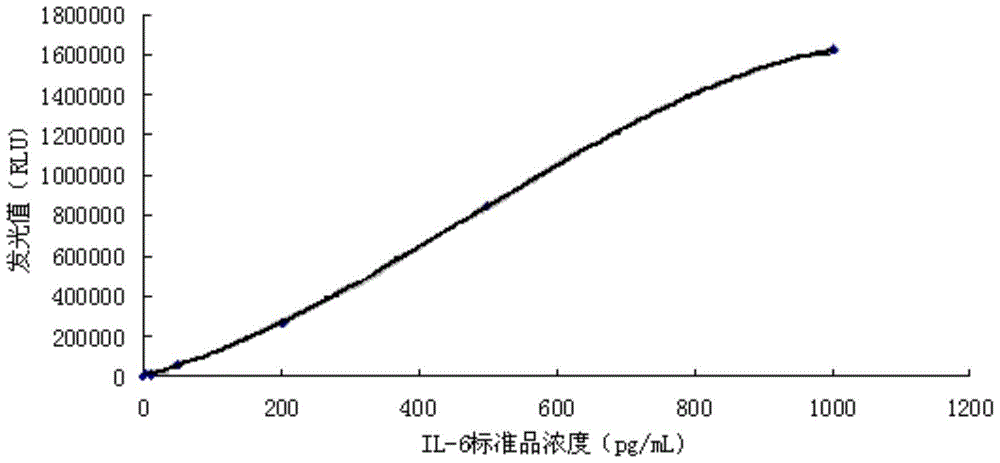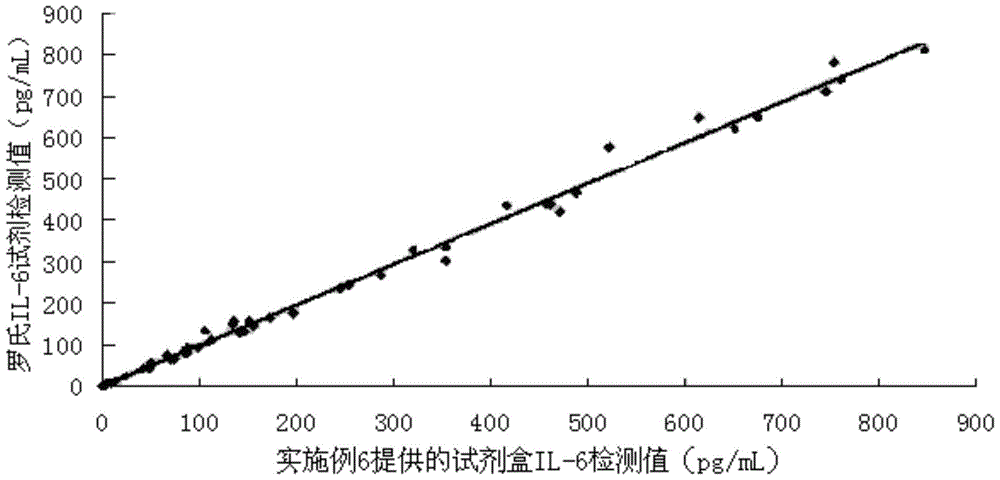A kit for detecting interleukin-6 and a method for detecting interleukin-6 for non-diagnostic purposes
A kit, IL-6 technology, applied in the field of immunoassay, can solve the problems of unfavorable automatic detection instrument detection, long detection time, low sensitivity, etc. Effect
- Summary
- Abstract
- Description
- Claims
- Application Information
AI Technical Summary
Problems solved by technology
Method used
Image
Examples
Embodiment 1
[0068] The preparation of the superparamagnetic particle of embodiment 1 avidin coupling
[0069] Take 10 mg of superparamagnetic particles (500 nm to 5 μm in diameter) whose surface active groups are carboxyl groups, place them on a magnetic separator for 2 min, discard the supernatant; add 4 mL of 0.05 mol / mL PBS buffer, pipette evenly, Place on a magnetic separator for separation for 2 min, discard the supernatant, and repeat washing twice. After cleaning, add 50 mg / mL EDC solution (pH 7.0) and 1200 μL of activated superparamagnetic particles, pipette evenly, place on a shaker, and react for 1 hour to obtain activated superparamagnetic particles. Then add avidin to couple streptavidin (SA) protein, the specific operation is: SA is dissolved with 10mmol PBS buffer solution, 1500μL of 5mg / mL SA solution is added to the activated superparamagnetic particles, placed in React on the shaker for 3 to 6 hours. After the coupling is completed, add 3mL of 1% bovine serum albumin (B...
Embodiment 2
[0070] The preparation of the superparamagnetic particle of embodiment 2 avidin coupling
[0071]Take 10 mg of superparamagnetic particles (1-3 μm in diameter) whose active groups are carboxyl groups on the surface, place them on a magnetic separator for 2 minutes, discard the supernatant; add 4 mL of 0.05 mol / mL PBS buffer solution, and pipette evenly , placed on a magnetic separator for separation for 2 min, the supernatant was discarded, and the washing was repeated twice. After cleaning, add 50 mg / mL EDC solution (pH 7.0) and 1200 μL of activated superparamagnetic particles, pipette evenly, place on a shaker, and react for 1 hour to obtain activated superparamagnetic particles. Then add avidin to couple streptavidin (SA) protein, the specific operation is: SA is dissolved with 10mmol PBS buffer solution, 1500μL of 5mg / mL SA solution is added to the activated superparamagnetic particles, placed in React on the shaker for 3-6 hours. After the coupling is completed, add 3mL...
Embodiment 3
[0072] Example 3 Preparation of Biotinylated Antibody
[0073] Take 1 mmol each of biotin, N-hydroxysuccinimide and dicyclohexylcarbodiimide, add them together to 6 mL of dimethylformamide solution, stir at room temperature (18-25 °C) for 18 h, filter, and decompress the filtrate The dry matter was washed repeatedly with ether, then redissolved in isopropanol, then concentrated to half of the original volume by vacuum drying, crystallized in a low-temperature refrigerator, filtered with filter paper, collected crystals, washed with ether and ready to use. Biotin N-hydroxysuccinimide ester (BNHS) was obtained.
[0074] With 0.1mol / L NaHCO 3 Solution Dilute anti-IL-6 monoclonal antibody A (from Thermo Fisher) to 2 mg / mL antibody solution, add 20 μL of BNHS (20 mg / mL) dissolved in dimethylformamide to each ml of antibody solution, mix well, and store at room temperature (22°C) to react for 1 hour, then dialyze in 0.1 mM PBS buffer solution for 24 hours at 4°C, and the reaction ...
PUM
| Property | Measurement | Unit |
|---|---|---|
| concentration | aaaaa | aaaaa |
| diameter | aaaaa | aaaaa |
| diameter | aaaaa | aaaaa |
Abstract
Description
Claims
Application Information
 Login to View More
Login to View More - Generate Ideas
- Intellectual Property
- Life Sciences
- Materials
- Tech Scout
- Unparalleled Data Quality
- Higher Quality Content
- 60% Fewer Hallucinations
Browse by: Latest US Patents, China's latest patents, Technical Efficacy Thesaurus, Application Domain, Technology Topic, Popular Technical Reports.
© 2025 PatSnap. All rights reserved.Legal|Privacy policy|Modern Slavery Act Transparency Statement|Sitemap|About US| Contact US: help@patsnap.com



